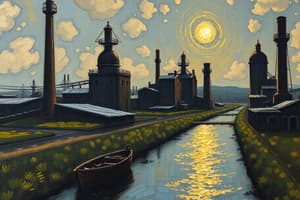Podcast
Questions and Answers
How did the Agricultural Revolution lead to the Industrial Revolution?
How did the Agricultural Revolution lead to the Industrial Revolution?
When farming methods improved, food supplies increased, and so did England's population; this led to increased demand for goods. Small farmers lost their land to enclosed farms and became factory workers.
How did an abundance of natural resources contribute to the Industrial Revolution?
How did an abundance of natural resources contribute to the Industrial Revolution?
Natural resources such as coal, water, and iron were all used to power and make machines.
How did political stability contribute to the Industrial Revolution?
How did political stability contribute to the Industrial Revolution?
With political stability, people could take out loans which led to entrepreneurs making new machines and expanding their businesses.
What are the factors of production?
What are the factors of production?
What technological advances were in the textile industry?
What technological advances were in the textile industry?
How did entrepreneurs support the Industrial Revolution?
How did entrepreneurs support the Industrial Revolution?
How did the building of factories contribute to the Industrial Revolution?
How did the building of factories contribute to the Industrial Revolution?
How did the railroads guarantee the success of the Industrial Revolution?
How did the railroads guarantee the success of the Industrial Revolution?
How did the Industrial Revolution change the lives of poor city dwellers?
How did the Industrial Revolution change the lives of poor city dwellers?
How did the Industrial Revolution change the lives of factory workers?
How did the Industrial Revolution change the lives of factory workers?
How did the Industrial Revolution affect the lives of wealthy merchants, factory owners, and shippers?
How did the Industrial Revolution affect the lives of wealthy merchants, factory owners, and shippers?
How did the Industrial Revolution affect the lives of children?
How did the Industrial Revolution affect the lives of children?
How did the Industrial Revolution change the lives of skilled workers and factory overseers?
How did the Industrial Revolution change the lives of skilled workers and factory overseers?
How did the Industrial Revolution affect large landowners and aristocrats?
How did the Industrial Revolution affect large landowners and aristocrats?
How was the environment changed after the Industrial Revolution?
How was the environment changed after the Industrial Revolution?
How was education changed because of the Industrial Revolution?
How was education changed because of the Industrial Revolution?
What were some favorable conditions that sparked industrialization in both Britain and the US?
What were some favorable conditions that sparked industrialization in both Britain and the US?
What factors led to the great expansion of US industry in the late 1800s?
What factors led to the great expansion of US industry in the late 1800s?
How did the Napoleonic Wars affect the development of industrialization in Europe?
How did the Napoleonic Wars affect the development of industrialization in Europe?
How did industrialization shift the world balance of power?
How did industrialization shift the world balance of power?
Flashcards are hidden until you start studying
Study Notes
Agricultural Revolution Impact
- Improved farming methods increased food supplies and population in England.
- Small farmers lost land to enclosed farms, becoming factory workers, which contributed to labor availability for industrial jobs.
Natural Resources Contribution
- Abundance of coal, water, and iron facilitated power for machines and production during the Industrial Revolution.
Political Stability Advantages
- Political stability allowed individuals to secure loans, enabling entrepreneurs to invest in new machinery and expand businesses.
Factors of Production
- The essential factors include land, labor, and wealth, which are critical for economic growth and industrialization.
Technological Advances in Textiles
- The shuttle increased weaving efficiency, producing double the amount daily.
- The spinning jenny allowed operation of 8 threads simultaneously.
- The spinning mule combined strengths of both technologies and offered consistent output.
Role of Entrepreneurs
- Entrepreneurs mitigated business risks, often spearheading the creation of innovative or improved machinery.
Factory System Development
- Wealthy textile merchants established factories to mass-produce goods, creating numerous job opportunities.
Railroad Impact
- Railroads streamlined transportation, making it easier to move goods and materials across regions.
Life of Poor City Dwellers
- Rapid industrial growth resulted in inadequate housing, lack of education, and unsanitary living conditions for urban poor.
Factory Workers' Conditions
- Factory workers faced hazardous environments with excessive working hours (13-16 hours daily) and high injury risks.
Middle-Class Emergence
- The Industrial Revolution fostered the development of a middle class, leading to a more comfortable lifestyle for wealthy merchants and factory owners.
Children's Exploitation
- Children as young as six worked in factories, often enduring severe punishments to keep them alert during long hours.
Skilled Workers and Overseers
- Skilled workers enjoyed improved living standards and higher pay throughout the 1800s compared to unskilled laborers.
Landowners and Aristocrats' Lifestyle
- Large landowners and aristocrats maintained comfortable lives and often viewed burgeoning businessmen with disdain.
Environmental Changes
- Industrialization caused significant environmental deterioration, including polluted water sources and poor air quality due to industrial waste.
Education Transformation
- Child labor laws prompted a rise in educational opportunities as factories required skilled workers, increasing the emphasis on education.
Industrialization Conditions in Britain and the US
- Britain’s favorable geography, political stability, and resource availability catalyzed its industrial growth, while the US benefited from similar resource abundance.
US Industry Expansion Factors
- Excess natural resources (oil, coal, iron) and a growing population created a demand for manufactured goods, while railroads facilitated distribution.
Impact of Napoleonic Wars
- The Napoleonic Wars disrupted trade and communication across Europe, resulting in inflation and stunted industrial development.
Global Power Dynamics Shift
- Nations rich in natural resources underwent industrialization, establishing themselves as powerful entities while others remained dependent on these emerging markets.
Studying That Suits You
Use AI to generate personalized quizzes and flashcards to suit your learning preferences.




